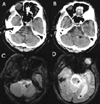Abstract
Spontaneous primary medullary hemorrhage is a rare event. A 64-year-old man was admitted for sudden-onset vertigo and vomiting. His clinical features were similar to those of lateral medullary syndrome. The patient had no anticoagulant therapy, vascular malformation, or a caudal extension of a pontine hemorrhage. The patient had multiple hypertensive changes, including retinopathy, left ventricular hypertrophy on electrocardiography, multiple cerebral microbleeds, and small-vessel changes on MRI. T2*-weighted gradient echo MRI performed 3 months prior to admission and contrast-enhanced MRI showed no evidence of vascular malformation. We concluded that the patient had uncontrolled hypertension that may have lead to primary medullary hemorrhage.
The medulla oblongata is a rare site of parenchymal hemorrhage, and the clinical features, optimal treatment, and prognosis of this condition are not well known. Parenchymal hemorrhage of the medulla has been attributed to anticoagulant therapy,1 vascular malformation, 2,3 or a caudal extension of a pontine hemorrhage. Here we present a case report of a patient with hypertension and primary medullary hemorrhage who had none of the above conditions.
A 64-year-old man with a 2-year history of uncontrolled hypertension was admitted due to sudden-onset vertigo. Three months prior to admission he had undergone brain MRI because of mild memory disturbance. At that time, T2*-weighted gradient echo (GRE) imaging (Magnetom Vision plus, Siemens, Erlangen, Germany) showed multiple cerebral microbleeds in the bilateral thalami and pons, but no microbleeds or abnormal lesions were observed in the medulla (Fig. 1). A fluid-attenuated inversion recovery image showed severe leukoaraiosis. He had been taking clopidogrel (75 mg/day) since then. At admission he complained of nausea, vomiting, vertigo, and dysarthria. A physical examination revealed normal vital signs except for a blood pressure of 160/95 mmHg. A neurological examination revealed right-beating nystagmus, ocular tilt reaction to the left and severe lateropulsion to the left, but no tongue deviation, sensory disturbance, or limb weakness. Horner syndrome, diplopia, facial weakness, and hearing loss were also absent. Deep tendon reflexes were symmetric, and plantar responses were flexor bilaterally. However, he showed severe limb ataxia in the left extremity and could not stand unassisted. Laboratory results of the coagulation panel were within normal limits. Electrocardiography showed left ventricular hypertrophy, and a retina photography showed grade I hypertensive retinopathy according to the Keith-Wagener-Barker classification and excyclotropia of the left eye of about 30°. Brain CT and T2*-weighted GRE imaging showed hemorrhage into the left dorsal medulla (Fig. 2). Incidentally, the intraventricular hemorrhage in the occipital horns of left lateral ventricle was in a layered blood-CSF pattern. After rehabilitation, his vertigo and ataxia improved and he was discharged on hospital day 21.
Spontaneous primary medullary hemorrhage is a rare event. The first surgically proven patient was described by Kempe in 1964.2 Subsequently, Morel-Maroger et al.4 and Biller et al.5 described the first cases of medullary hemorrhage diagnosed by CT and MRI, respectively.
The causative role of hypertension in medullary hemorrhage is controversial. Barinagarrementeria and Cantu6 reported 16 cases of medullary hemorrhage, including 12 literature cases. The mechanism of the medullary hemorrhage was determined in 7 of these 16 patients: ruptured vascular malformation in 3, hypertension in 3, and anticoagulant treatment in 1. Of these 16 cases, 4 had primary medullary hemorrhage, and only 1 of these was attributed to hypertension. Neumann et al.7 reported one autopsy case of medullary hemorrhage due to hypertensive vasculopathy.
In view of the radiological and clinical findings in the present case, it was unnecessary to invoke an etiology on occult vascular malformation or pontine hemorrhage with caudal dissection. T2*-weighted GRE imaging performed 3 months prior to admission and contrast-enhanced MRI showed no evidence of vascular malformation. The patient had multiple hypertensive changes, namely retinopathy, left ventricular hypertrophy, multiple cerebral microbleeds, and small-vessel changes on the MRI. He had no anticoagulant therapy or coagulopathy. Furthermore, he had no symptoms or signs of medial medulla or pontine lesions, and so was diagnosed as primary hypertensive medullary hemorrhage.
The outcome of medullary hemorrhage is generally good.6 Our patient recovered from assisted standing to a normal gait. The good prognosis in this patient was due to the hemorrhage extending into the fourth ventricle more than to the medial medulla and pons. Brain CT and T2*-weighted GRE MRI showed that the hemorrhage ruptured into the fourth ventricle and flowed backward into the left lateral ventricle. We concluded that the patient had uncontrolled hypertension and this may have caused the medullary hemorrhage.
Figures and Tables
Figure 1
Brain images of the patient before admission. Three months prior to admission, T2*-weighted GRE MRI showed multiple cerebral microbleeds in the thalamus (A) with no abnormal vasculature in the medulla (B). The fluid-attenuated inversion recovery image showed diffuse periventricular white-matter changes (C).

Figure 2
Brain images of the patient at admission. Brain CT (A, B) and T2*-weighted GRE MRI (C, D) showed hemorrhage in the left dorsal medulla, which ruptured the dorsal medulla and extended into the fourth ventricle (arrow). The layered blood-CSF pattern of the intraventricular hemorrhage was due to backward flow of blood into the occipital horn of the left lateral ventricle (D) (arrowhead).

References
1. Mastaglia FL, Edis B, Kakulas BA. Medullary hemorrhage: a report of two cases. J Neurol Neurosurg Psychiatry. 1969. 32:221–225.
2. Kempe LG. Surgical removal of an intramedullary haematoma simulating Wallenberg\'s syndrome. J Neurol Neurosurg Psychiatry. 1964. 27:78–80.

3. Cohen HC, Tucker WS, Humphreys RP, Perrin RJ. Angiographically cryptic histologically verified cerebrovascular malformations. Neurosurgery. 1982. 10:704–714.

4. Morel-Maroger A, Metzger J, Bories J, Gardeur D, Verger JB, Noel MC. Non-lethal brain stem hematomas in hypertensive patients. Rev Neurol (Paris). 1982. 138:437–445.
5. Biller J, Gentry LR, Adams HP Jr, Morris DC. Spontaneous hemorrhage in the medulla oblongata: clinical MR correlations. J Comput Assist Tomogr. 1986. 10:303–306.




 PDF
PDF ePub
ePub Citation
Citation Print
Print


 XML Download
XML Download